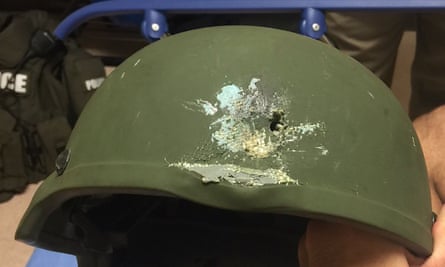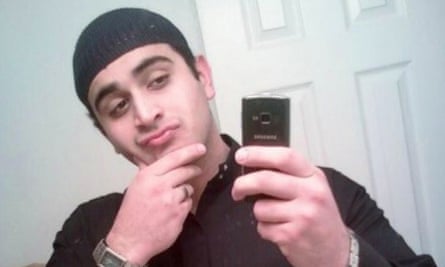“Everyone get out of pulse and keep running.”
It was after 2.30am in Orlando, at least half an hour after the shooting began, when someone managed to post on the Facebook page of the Pulse nightclub, a haven for the vibrant LGBT community of central Florida.
Barely a day earlier, the police chief, John Mina, had held a press conference about another shooting, in which a gunman murdered the pop singer Christina Grimmie and then killed himself.
“We’ve never had an issue here that I’m aware of, especially anything of this magnitude,” Mina said on Saturday.
On Sunday, his department was confronted with the deadliest mass shooting in American history: at least 50 dead, 53 wounded, many in grievous condition.
On Saturday night, the sprawling club in downtown Orlando opened to Latin Night, one of the venue’s nightly themed events. A drag queen from Puerto Rico was scheduled to perform at the club, where more than 100 people were celebrating the Saturday after Orlando’s 25th Gay Days festival. A Cyndi Lauper song was on, a witness later said, when the shooting began at about 2am.
Anthony Torres was sitting in the VIP section of the bar, near the entrance, and about to leave when it began.
“It seemed fake,” he later wrote on a social media post. “This had to be planned.”
Torres wrote that he saw people “screaming and running, looking for their loved ones” and saw other “injured people sitting on the floor”. He and his boyfriend, sister and friends ducked out the door.
An Orlando police officer was on duty outside the club and moved to confront the gunman, Mina told reporters on Sunday. The officer drew the gunman outside on to Orange Avenue, where they exchanged fire. Then the shooter re-entered the club and started firing again.
“At first, when I heard the shots, I thought it was part of the music, but then we realized it was really happening,” Kenneth Melendez told the Orlando Sentinel. “I started running and saw someone bleeding from the arm and I was like, ‘Wow, this is really happening,’ and I kept running.”
Four of his friends were shot and taken to hospital, he said.
Another survivor, Christopher Hansen, also mistook the first sounds of discharge to be part of the DJ’s set.
“You think you hear a song, it’s music, and then you realize no, it’s not, it’s real life, there’s somebody actually shooting,” he told a reporter outside the club. “It’s not OK. It’s not.”
Hansen said he dropped to the ground and saw red liquid spill on to the woman next to him – in his shock, he at first thought it was someone’s fallen drink. A man nearby fell, shot in the back, and Hansen tried to stanch the bleeding with a bandanna while “the continuous bang of the gun” echoed through people’s screams. He started to crawl to safety, dragging the injured man behind him.
He added that he knew the gunman must have had more than a handgun: there were too many shots. The police chief later said he had an “AR-15-type assault rifle” and a handgun. He fired dozens of rounds.
Outside, dozens of officers arrived from departments and agencies around central Florida. Swat teams, FBI agents and a bomb squad with dogs joined them. The county sheriff, Jerry Demings, later said more than 100 personnel arrived in the dark hours of the morning.
Inside the club, people scattered. Some hid in bathrooms, where they tried to contact police, partners, friends, parents. A local station, WFTV, broadcast several of the texts to family on the air. A mother recounted a text from her daughter and two nieces: “‘Please come and get us. Please come and get us now. They’re shooting. They’re shooting.’”
The station also showed texts from a man to his mother, sent from hiding. “Mommy I love you,” he wrote in one. “In club they shooting.”
“He’s coming,” he wrote in another. “He’s in the bathroom with us.”
Injured people trickled out of the club however they could, piling on to stretchers and into ambulances as the sole mass trauma hospital in the area rushed into emergency protocol. The witness Anthony Torres posted a video of the long line of vehicles, their lights blinking, and wrote a caption: “They are just pulling people out in stretchers loading them up.”
Survivors milled around near the police and the first reporters and family to arrive. One man discovered his shirt smeared with blood – whose, he didn’t know. Helicopters hovered above and police barricaded the streets with cars and flares. Families waited in terror for word or sight of their family. An ER assistant who happened to be at the club with a friend – he saw her shot in the shoulder – helped workers in the street and then rushed to the hospital.
“People bleeding everywhere,” he tweeted.
Eventually the shooting stopped and police made contact with the gunman, who had taken hostages. Mina declined to describe those talks on Sunday morning.
The standoff lasted for hours, while people inside the club continued to hide and plead for help. A mother, Mina Justice, said her son texted her to say that he didn’t want to look at the man for fear of being shot.
“He said, ‘He has us, and he’s going to kill us,’ and that was it.”
Another mother, Lilbia Carmen, appealed for news on Facebook.
“Nothing yet. My daughter is in there. Please keep praying for them,” she wrote. “She’s waiting for cops to be able to come out. I was on the [phone] and all I hear is shot guns.”
At about 5am the police and FBI decided they could not wait any longer. “Our biggest concern was further loss of life,” Mina later told reporters.
Two loud explosions startled the press and survivors still within earshot of the club – two controlled blasts “to distract the suspect and gain that advantage”, Mina said. Then an armored Bearcat truck smashed through a bathroom wall to free people while nine officers stormed the building, beginning a new battle with the shooter.
The gunman struck one of the officers with a bullet, but the man was saved by his Kevlar helmet, Mina said. The shooter was shot dead and about 30 people were rescued.

In addition to the weapons, police found a suspicious device on the suspect’s body, and the need to clear the club kept them from seeing the scope of the tragedy. A bomb-defusing robot rolled inside, and they found the object was not an explosive device as feared.
But the death toll surpassed authorities’ worst fears. They had estimated about 20 people killed at an initial briefing. After entering the club they found 30 more bodies, 50 in all and many more in dire condition, marking the worst mass shooting in US history.

Later on Sunday, a 27-year-old man, who did not want to be named, showed reporters a bloody scratch across his stomach where he said a bullet had grazed him. The man said he had been standing at the bar, paying his bill, when the shooting started. He was carried across the bar by the weight of others rushing to escape, he said, and ended up underneath a pile of people.
When he was able to look up, he said, he saw about 20 bodies apparently dead or badly wounded on the floor around him.
He said he joined others in a rush to the door and found himself in the parking lot.
“People were pushing and shoving each other to get out. It was like cows at a slaughterhouse,” he told reporters.
The man lost his shoes and shirts in the scramble to escape, he added.
Police did not announce the name of the killer, who was found to have arrived at the club in a van, but law enforcement sources told media that he was Omar Mateen, a 29-year-old from Fort Pierce, Florida. The FBI special agent Ronald Hopper said the case was being investigated as an act of terrorism.
He added that the FBI was investigating whether the killer was inspired by jihadi terror groups, saying: “We do have suggestions that that individual may have had leanings toward that particular ideology. But right now we can’t say anything definitively.”
The mayor of Orlando, Buddy Dyer, declared a state of emergency, and alongside Mina, Hopper and a local imam urged Americans to give blood and unite. “It’s a tragedy not only for our city, but for the entire nation,” Mina said.
None felt the tragedy more keenly than families. Carmen’s daughter escaped the carnage, leaving her mother overwhelmed with relief. The children of dozens of other parents did not.







